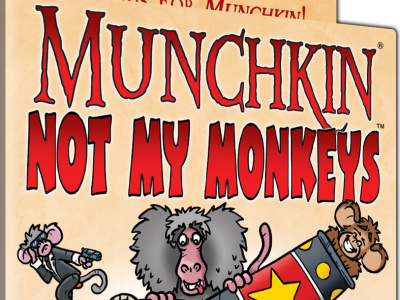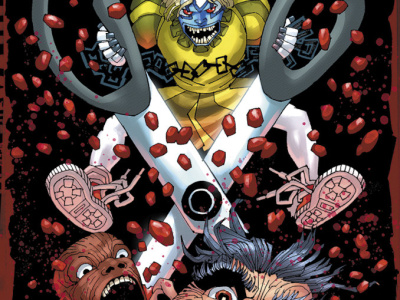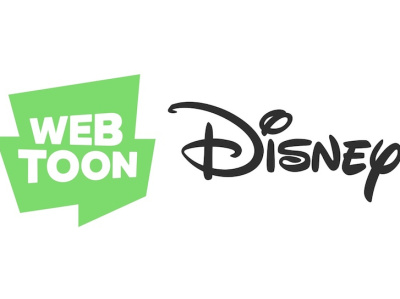The first thing I want to do is understand when DC uses variant covers and how. It's my impression that at least for the last couple of years you've been using variant covers to mark second printings, is that right?
We don't have any hard and fast rule but yes, I would say most of our second printings in the last couple of years have had a variant cover. There are other variant covers we've done in the last two years. We did a variant cover on the final issue of the Jeph Loeb/Jim Lee Batman, where we had the villain cover for one and the hero cover for the other.
Was that fifty/fifty?
Yes. Then we opened up the codes and allowed retailers to increase their order on the hero versus the villain, if they wanted to change the spread. That one, because of the size of the orders and the interest, we converted over to individual codes. We've also done a couple of variant covers as gifts for retailers participating in various DC functions. When we launched each of the America's Best Comics titles that were part of an interlocking universe, we had a variant cover by Alex Ross on each of those books. We've used variants in different ways.
Prior to a couple years of ago, you weren't using variant covers for second printings, at least not routinely.
That's correct.
When did that change?
There was no clear point of demarcation. It gradually changed. In the past when we did multiple printings, we used to put a Roman numeral on it so that people bagging comics for later resale could tell which printing they were bagging. Then we went to having UPC/direct market bar codes on the covers. The extension on the bar code has the printing number information. It seemed like that was redundant so we did away with putting on the Roman numerals at that time. You remember we went for a number of printings on Batman: The Killing Joke, changing the logo color every time we went to a new printing. We've done a lot of things. Some were subtle, some not-so-subtle.
What's the sales impact of doing a second cover?
On the first printing or on the second printing?
On the first printing. Like Batman: Hush. How many more do you think you sold because you had two covers?
On the final issue of Batman: Hush, because they were multi-fold-out covers, it was probably more dramatic than it would have been normally. The impact of doing a second cover on the first printing is somewhat related to more than just one factor. The level of interest that the marketplace has in the character itself is a factor. The level of interest the marketplace has in the talent that's doing the cover on the regular series and the cover of the variant is a factor, just the general heat in the marketplace. On the high end books where we've done two covers on solicitation, it generally has been a matter of twenty-five to thirty per cent more. It's probably a more modest impact further down on our list.
What about on the second printings? Do you think there's a sales impact there also?
On a second printing I think it's probably about a fifty per cent swing.
So the main reason to do variant covers is to sell more copies?
To help our retailers sell more copies and for DC to sell more copies. Also just to give people something to talk about and build interest and excitement in the shop on the Wednesday when the new books come in. On a first printing there's the hope in some shops of being able to get two facings for the books, especially when most of our stuff is done with a fifty/fifty ratio. Just to increase the facings, the awareness of the book, and try to catch the eye.
Why do you use a fifty/fifty ratio on some covers? You said in some cases you let retailers order individual SKUs. In other cases you just do a fifty/fifty mix. The fifty/fifty mix would seem to be a tougher ordering problem on the retailer. What are your thoughts on that?
Sometimes the opportunity to do variant covers doesn't coincide perfectly with the solicitation process. At other times, it's just there as a way of getting extra attention from retailers and readers. The only time I can remember that we've broken the codes apart was on the final chapter of the Batman: Hush storyline. We actually had three SKUs on that. Since the multi-fold added such a level of expense, we didn't want to put those out returnable through the ID system. We had one cover style for the ID system and the two that were designed primarily for the direct sales market. Historically, we've tried, whenever we've offered something, even when it seems less desirable to the ID system, to offer the copies through Diamond or their sales agent so we don't end up with people migrating from one channel into another just to get something because it's perceived to be collectible. That's been the only time we've done that. The numbers were just so high.
The issue at the retailer level is, if one cover is more desirable than the other, and they're packed in even quantities, that means that he or she has to order some product he doesn't want to get product he does want. That might cause an inventory issue. What's your reaction?
We've almost had no feedback from retailers. Although I suspect by saying this, I'll ensure we get some feedback. We've had no negative feedback from retailers about the fifty/fifty split. Most retailers think the fifty/fifty split helps sell more comics and create more interest, or they're operating from a very pure standpoint. They don't think there should be any variant covers at all. They don't care if it's a fifty/fifty split or a more terraced, okay, you have to buy a hundred copies of these seventeen books and jump through three hoops on a full moon to get the one super-duper cover.
I've seen the assertion that DC added variant covers for Superman/Batman #10 and Superman #205 as a way to make sales greater after the orders were in and as a way to get the top of the best seller chart for May. Your reaction?
Since Diamond only reports final orders, we don't have any way of knowing what the orders might be for our competitors to adjust and react. We're talking about doing things with these covers pretty far in advance. It was generated in a conversation Dan DiDio and I had with Jim Lee. We don't just...y'know, we don't sit around plotting out in that fashion.
How would you respond to the argument that variant covers encourage speculation and an emphasis on the after-market value rather than on the entertainment value?
Depending on how you do a variant cover, it's a matter of degrees. I think there is some possibility on any variant cover that it increases the possibility of someone buying more than one copy, and buying it for speculation. I think the fifty/fifty split, because it puts a substantial number of copies of both covers into the channel, tends to make it where it's not a highly collectible item in that respect. I don't think it causes a substantial amount of speculation. Smaller quantities certainly lead to folks who are interested in speculation. The general rule of thumb is we try not to publish original story material in a format that's unreasonably inaccessible because of a limited run. Variant covers don't seem as compelling a distinction as the actual story content. I don't have in my collection every variant cover that DC's produced in the sixteen and a half years that I've been here. I haven't felt compelled to keep one of each, and I probably had the easiest access of most people reading this interview.
Some people see increasing use of variant covers and they're concerned. They saw it happening in the early 90s, which led to the speculative bubble that exploded rather painfully. What are your thoughts on that observation?
A lot of this has been spurred by comments of folks being interviewed in the last few weeks, and the speculation that we're somehow plotting to deprive another publisher of their rightful place on the charts. There were a lot of factors that caused the last bubble to burst. I don't think the variant covers were the only factor. DC looks for feedback from retailers and readers. If we get lots of feedback saying we've gone too far then we'll recalibrate. Right now we're comfortable with the level that we're at. It's not like we're planning to have one or two every week.
I don't think we're anywhere near the levels we were at in the early nineties, I think it's just a trend that people are seeing that's causing them concern.







